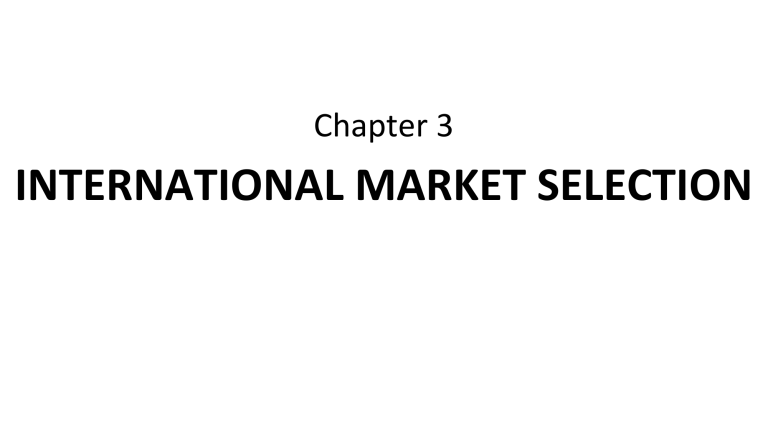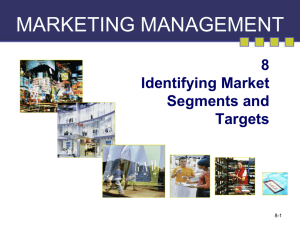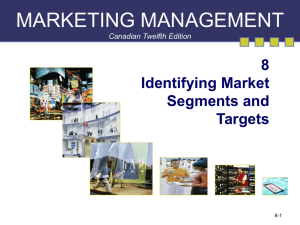
Chapter 3 INTERNATIONAL MARKET SELECTION Objectives After completing this chapter, students can: 1. Identify the variables that can use to segment global markets and give an example of each. 2. Explain the Market selection process, procedure, and strategy 3. Understand the global market segmentation 4. Be able to evaluate the market portfolios Content 1. Segmentation process 2. Regional, trans-national and global segments 3. Global market segmentation 4. Market selection process, procedure, and strategy 5. Evaluating overall foreign market portfolios 3 1. MARKET SEGMENTATION MARKET SEGMENTATION The process of classifying customers into homogeneous groups with similar demand and/or preferences. (Bruning et al ., 2009, p. 1500) A process whereby unique customer groups can be identified in country-based/ individual consumer-based groups. (Bruning et al ., 2009, p. 1500). MARKET SEGMENTATION • Internationally oriented firms largely depend on resource based advantages, high quality products (tradition, chance, or production philosophy), and long-term personal relationships and commitment in developing their niche strategies • can generate specialization. • involves costs, risks, and possible weaknesses • analysis of market behavior: channels, customer segments, or use occasions as well as the geographic dimension MARKET SEGMENTATION • Measurability (size, purchasing power, ..) • Accessibility (effectively reached and served ) • Profitability (large and/or profitable) • Actionability (formulated for attracting and serving the segments) Types of segmentation methods • • • • Demographic segmentation Psychographic segmentation Behavior segmentation Benefit segmentation For example • 600 million SE Asian consumers, 70% under age 40 • India has the youngest demographic profile among the world’s large nations; 2/3 are younger than 35 • Half of Japanese will be 50+ years. by 2025 • EU consumers under 16 almost as large as over 60 • 20% of Americans (70 million) will be 65+ by 2030 • U.S. ethnic groups-African/Black, Hispanics, & Asian Americans have a combined annual buying power of $3.5 trillion • US is home to 28.4 million foreign-born with income of $233b 2. SEGMENTATION SCENARIOS SEGMENTATION SCENARIOS Country segments Regional segments - Similarity across regional level Transnational segments - Segments based on similar needs across a group of countries - Country clusters Global Segments - Segments transcending national boundaries with common needs 3. GLOBAL SEGMENTS GLOBAL SEGMENTS ! “Homogeneous entities categorized by psychographic and behavioural similarities” (Doole, Lowe & Kenyon, 2018) ! “.. defined based upon market variables other than national boundaries (Hassan, 2011) ! Share core values, attitudes and aspirations ! Recognition that world markets consist of similarities and differences as distinguishing characteristics ! Segmentation across markets rather than within - consumers, not countries ! Problem if geographically spread “The process of identifying specific segments, whether they be country groups or individual consumer groups, of potential customers with homogeneous attributes who are likely to exhibit similar responses to a company’s marketing mix” (Hassan & Katsanis, 1991) GLOBAL SEGMENTS • Affluent consumers • Teenagers • International business travelers • Technology geeks • Similarity of needs depends on product categories e.g. high-tech consumer durables, travel-related products “Global consumers are willing to put their money where their heart is when it comes to goods and services from companies committed to social responsibility”. (Nielsen, 2014) “China remains an engine of growth for luxury goods as the country’s middle class continues to grow in size and purchasing power”. (Bain & Co, 2016) “A group of teenagers randomly chosen from different parts of the world will share many of the same tastes.” “GLOBAL ELITE” SEGMENT “Affluent consumers who are well travelled and have the money to spend on prestigious products with an image of exclusivity” Characteristics: • • • • Increased wealth Well travelled Prestige products universally High quality products GLOBAL TEEN SEGMENT “Teenagers sharing memorable experiences which are reflected in their consumption behavior. Young consumers whose cultural norms have not become ingrained and who can share universal needs, wants and fantasies” • Internet • Social media • International education Characteristics: • • • • Frequent travel Appreciation of future trends, fashion & music Self- conscious about way they look Role models influence choices • Music important communications tool GLOBAL TEEN SEGMENT • As cultures converge, teenagers around the world become more similar • They use well-known global brands like iPhone, Facebook, Nike, YouTube, Tiktok, Coca Cola … • They wear the same clothes and want to look and feel right… GLOBAL KIDS • Are children around the world becoming more similar? • Watch TV/Netflix, play computer games, download films, go to McDonalds/ KFC • International success of TV programmes like Teletubbies, Harry Potter books and films, Nintendo games, Disney Psychographic Segmentation • • • • Based on attitudes, values, and lifestyle Lifestyle surveys S R I International’s Values and Life Styles, V A L S & V A L S2 Porsche example • Top Guns (27%): Ambition, power, control • Elitists (24%): Old money, car is just a car • Proud Patrons (23%): Car is reward for hard work • Bon Vivants (17%): Car is for excitement, adventure • Fantasists (9%): Car is form of escape Behavior Segmentation • Focus on whether people purchase a product or not, how much, and how often they use it • Usage rates: heavy, medium, light, non-user • User status: potential, non-users, ex-users, regulars, first-timers, users of competitor’s products • 80/20 Rule or Law of Disproportionality or Pareto’s Law-80% of a company’s revenues are accounted for by 20% of the customers Benefit Segmentation • Benefit segmentation focuses on the value equation Value = Benefits / Price • Based on understanding the problem a product solves, the benefit it offers, or the issue it addresses VALS SEGMENTATION (Values – Attitudes – Lifestyles) HIGH RESOURCES • Innovators LOW RESOURCES • Believers • Thinkers • Strivers • Achievers • Makers • Experiencers • Survivors GLOBAL, LOCAL & FOREIGN • Global Consumer Culture Positioning (GCCP) • Brand symbolic of global consumer culture • Local Consumer Culture Positioning (LCCP) • Brand global, but portrayed as an intrinsic part of local culture • Foreign Consumer Culture Positioning (FCCP) • Build brand mystique around specific foreign culture, usually with positive connotations “The fact that pizza-loving consumers are found in many countries does not mean they are eating the exact same thing.” (Keegan & Green, 2008) “Globalization will probably never reduce the complex human system to a state of homogeneity” (Rugimbana & Nwankwo, 2003) TRENDS INFLUENCING GLOBAL CONSUMPTION - Spread of global consumer culture - Global flow of distinctive, cultural resources - Increases in GNP per capita - Rise in life expectancy - Increase in education & literacy levels - Growth in urbanization in developing countries - Advances in transportation and communications - World travel - Global acceptance of certain consumer products (beverages, fast food, fashion, cars, electronics) 4. Market selection process, procedure, and strategy MARKET SELECTION PROCESS • Reactive approaches passive, informal, unsystematic, responding to situation, used by small and medium-sized exporters, short term profit motive. • Proactive approaches active in initiating market selection, formal process. Influencing factors: • Psychic distance – feeling of uncertainty about foreign markets, perceived difficulty of finding information • Cultural distance – the perceived differences between the manager’s own and the destination culture • Geographic distance – proximity. MARKET SELECTION PROCEDURES Expansive methods: home market starting point, based on similarities and experience, use of market clusters selection Contractible methods: optimal market selection, starts with large number, systematic screening leading to elimination MARKET SELECTION PROCEDURES • • • 3 stages of Contractible methods 1. Preliminary screening criteria for examining countries are identified (feasible countries) 2. Determines country characteristics in evaluating marketing opportunities and how each should be weighted (operating risks, market potential, costs, and potential local and foreign competition) • • 3. Ranking of markets on the basis of scores derived Step 1: Geographic segmentation → ⤑ → Estimation of sales potentials Markets Segments → → Strategic planning ⤑ ⤑ General market indicators Product-specific market indicators Prohibitive product characteristics Prohibitive market characteristics Estimation of market potentials→⇢ Social-economic segmentation Demand patterns Quantitative indicators Qualitative indicators Supply patterns Competition Distribution Media ⤑ Potential markets screening Estimation of profitability Ranking of markets/ segments Final market selection MARKET SELECTION PROCEDURES • Step 2: Customer segmentation On the demand side behavior, lifestyle, attitudes, buying patterns, and decision-making must be included for both consumer and industrial markets • On the supply side - competitors nationalities, capacities, activities - distribution channels characteristics availability, capacities, and activities performed - media situation availability, costs, circulation, and priorities. Step 1 + 2 → estimate market share, estimate profitability • • • • MARKET SELECTION STRATEGIES Market spreading Market concentration • Allocating resources over large • Channeling resources into small number of markets number of markets • Fast growth rate at early stages of • Devoting high levels of marketing expansion effort & resources to each market • Focus on reducing risk • Slow and gradual expansion to other countries or segments • Can create entry barriers to competitors • More intensive development can create higher market shares and strong competitive position • INFLUENCING FACTORS Market spreading Market concentration Company factors High management risk-consciousness • Objective of growth through market development • Little market knowledge Product factors • Limited specialist uses • Low volume • Nonrepeat • Early or late in product life cycle • Standard product saleable in many markets • • • • • • • • • Low management risk-consciousness Objective of growth through market penetration Ability to pick ‘best’ markets General uses High volume Repeat-purchase product Middle of product life cycle Product requires adaptation to different markets INFLUENCING FACTORS Market spreading Market concentration Market factors • Small markets – specialized segments • Large markets – high volume segments • Unstable markets • Stable markets • Many similar markets • Limited number of comparable markets • New or declining markets • Mature markets • Low growth rate in each market • High growth rate in each market • Large markets are very competitive • Large markets are not excessively competitive • Established competitors have large share of key markets • Key markets are divided among many competitors • Low source loyalty • High source loyalty Marketing factors • Low communication costs for additional markets • Low order handling costs for additional markets • High communication costs • Low physical distribution costs for additional markets • High order handling costs • Standardized communication in many markets • High physical distribution costs • Communication requires adaptation to different markets 5. EVALUATING OVERALL FOREIGN MARKET PORTFOLIOS MARKET SELECTION STRATEGIES Market/Country attractiveness Competitive strength strength of a product/company as compared to competitors. • Market size (total and segments) • Market share (achievable) • Market growth (total and segments) • Marketing ability and capacity • Market seasons and fluctuations • Product and positioning fit • Competitive conditions • Contribution margin (concentration, intensity, entry barriers, etc.) • Image • Market prohibitive conditions (tariff, • Technology position nontariff barriers, import restrictions, • Quality of distribution services etc.) • Patents • Price levels • Market support • Profitability • MARKET PORTFOLIOS • Invest: The market is very attractive (size & its potential for • • • • growth), suitable for entry and major investment. Divest/ license: The company will have problems or need to make heavy investments to gain some market share. (better to do through ‘licensing’ - least demanding of resources). Joint Venture: Market attractive but difficult, require huge investments/resources to gain considerable/acceptable market share Export: The market is not attractive due to its size or segment growth, not to make heavy investments & to sell the product through exports. Selective strategy: fierce competition & difficult to maintain a stable market share, could invest if product/positioning fit with the market or have a powerful brand. ? • Give examples of global market segments and companies that are marketing on that basis. Can small and medium-sized enterprises market successfully to such segments? Explain. • Distinguish between expansive and contractible market selection procedures. If you were making a decision on such a procedure, which would you favor, and why?







